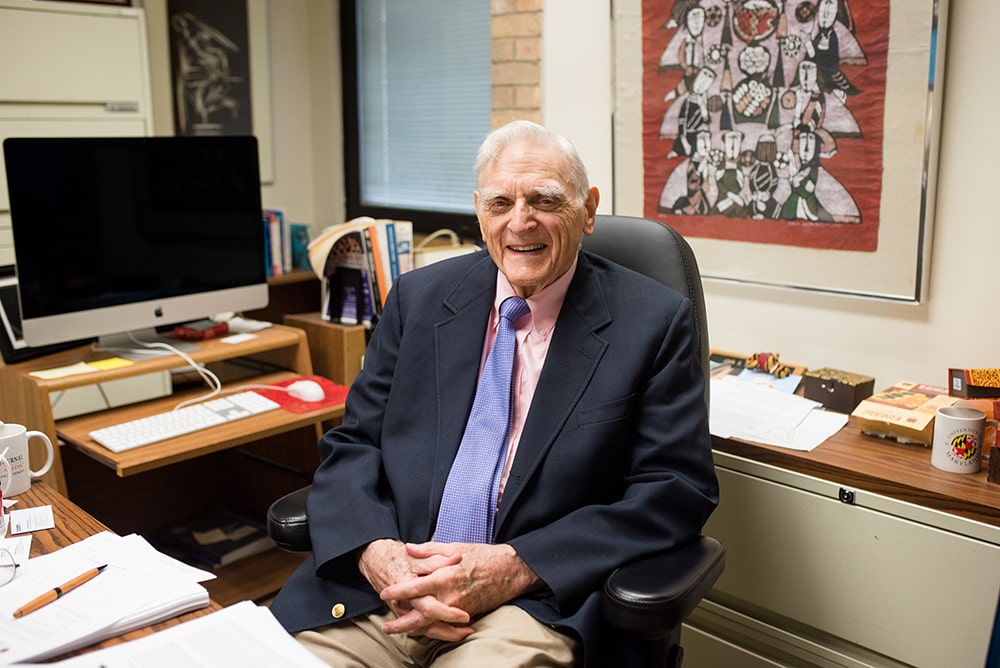White House Presents 2009 Enrico Fermi Award to John Goodenough for Lifetime Achievements

John Goodenough, professor in the Cockrell School of Engineering
The University of Texas at Austin engineering professor John Goodenough, who developed materials critical to the development of lightweight and rechargeable lithium-ion batteries, ushering in the wireless revolution, has been awarded the Enrico Fermi Award, one of the most distinguished science and technology honors given by the White House.
Goodenough will share the presidential honor with Stanford University’s Siegfried S. Hecker. Each will receive a gold medal and share the $375,000 honorarium. Both will be honored at a ceremony in Washington, D.C. at a later date. The award is administered on behalf of the White House by the U.S. Department of Energy.
Goodenough, who holds the Virginia H. Cockrell Centennial Chair in Engineering, is receiving the award in recognition of his lasting contributions to materials science and technology, especially the science underlying lithium-ion batteries.
He said he had the privilege of taking two courses (quantum mechanics and nuclear physics) from Fermi while attending the University of Chicago.
“It is a special honor to receive a prize named after him,” Goodenough said. “When I arrived at the University of Chicago at the end of World War II, the registration officer said to me, ‘I don’t understand you veterans. Don’t you know that anyone who ever did anything significant in physics had already done so by the time he was your age, and you want to begin?’ But I had the good fortune to have the opportunity to build a bridge between physics and both solid-state and electrochemistry to achieve some targeted technological goals, as well as to pursue fundamental studies in the field of solid transition-metal compounds.”
He credited the institutions where he has taught since 1952 for providing a supportive environment where “experimental colleagues” were vital for the realization of his work.
“I salute every one of these silent partners who stand behind this award.”
John B. GoodenoughProfessor, Cockrell School of Engineering
Gregory Fenves, Cockrell School of Engineering dean, said: “Our mobile world of communications, computing, entertainment, and increasingly transportation, has been enabled by Dr. Goodenough’s fundamental scientific discoveries and technological innovations in energy storage.”
Goodenough, a physicist and a mechanical engineer, identified and developed the cathode materials for the lithium-ion rechargeable battery that is ubiquitous in today’s portable electronic devices. This cathode material for power batteries has proven to be inexpensive, environmentally friendly, safe, sustainable, and capable of thousands of charge cycles with a constant output voltage without a loss of capacity. Batteries incorporating his cathode materials are used worldwide for cell phones and other portable wireless devices, power tools, hybrid automobiles, small all-electric vehicles, as well as increasingly for electrical energy storage for alternative energy, such as wind and solar power. As this technology continues to develop, it can be expected to have an enormous impact on the U.S. economy and the environment by helping to reduce carbon dioxide and greenhouse gas emissions.
Goodenough earned his Ph.D. in physics in 1952 from the University of Chicago. He was a research engineer at Westinghouse before moving to the MIT Lincoln Laboratory as a research scientist and group leader from 1952 through 1976. He continued his career as professor and head of inorganic chemistry at Oxford University and, after retiring from Oxford, returned to the United States in 1986 to join The University of Texas at Austin.
“The 2009 Enrico Fermi Award will go to two scientists who have selflessly devoted themselves to our nation’s energy and national security challenges,” said U.S. Secretary of Energy Steven Chu. “These two individuals are pioneers in innovative research, and I want to thank them for their work and congratulate them on this award.”
About the Fermi Award
The Fermi Award is one of the oldest and most prized science and technology awards given by the U.S. government, and honors the memory of Nobel Laureate Enrico Fermi. The most recent award was presented to Arthur H. Rosenfeld in 2005.
